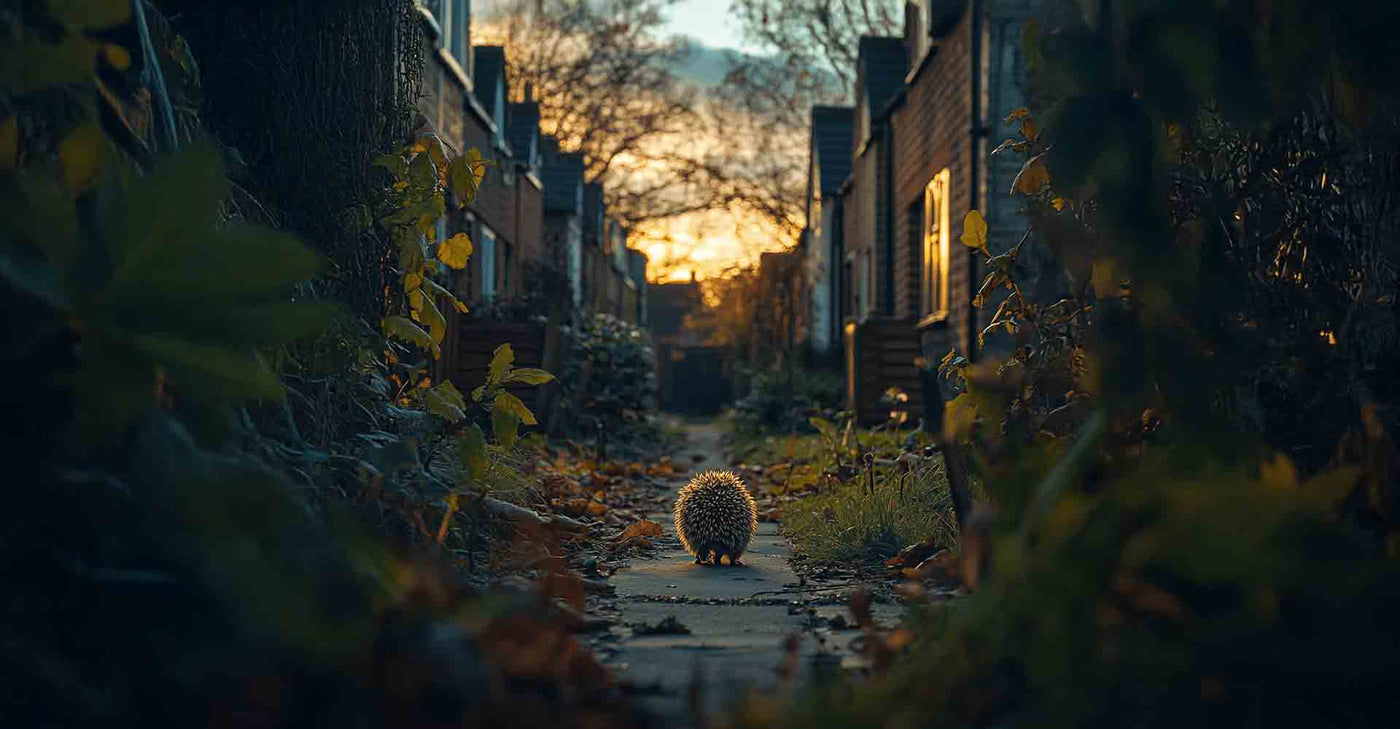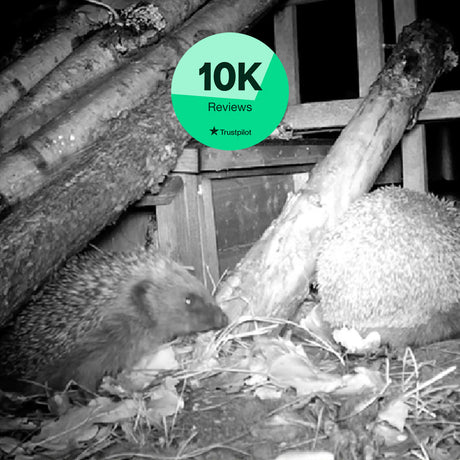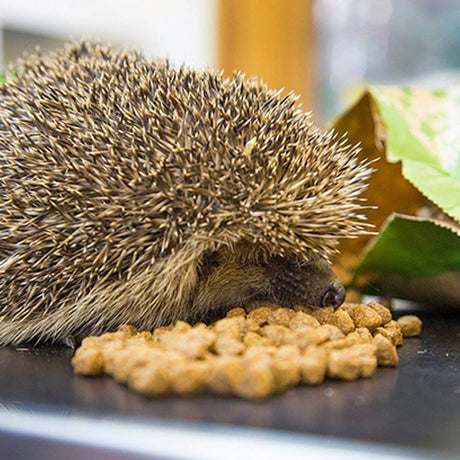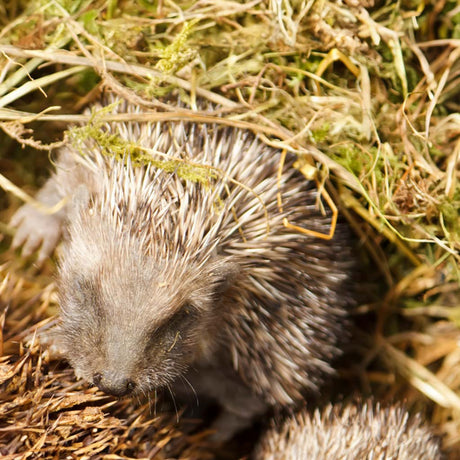Where Do Hedgehogs Live?
Before we look at where hedgehogs live, let's take a quick look at what a hedgehog needs from her home. Hedgehogs must live somewhere that will provide them with:
Food. As we know hedgehogs are insectivores, they eat mainly invertebrates with a preference for beetles, caterpillars and worms. They will also eat slugs and snails and occasionally eggs, frogs or even baby birds. An adult hedgehog must eat around 3 oz of food each night (more in the run-up to hibernation). The habitat must provide this food.
Water. Although hedgehogs don't tent to bathe like birds, they do need to drink, so a clean water source is essential for hedgehogs to live.
Nesting sites. Hedgehogs build 3 types of nest during the year: nests for daytime naps, nests for raising hoglets and nests for winter hibernation. The nests are made out of grasses, leaves and twigs and generally situated in dry, sheltered places. Hedgehog habitat must provide suitable nesting sites and nesting materials.
Protection from Predators. With all those spines, the hedgehog carries around her protection from most predators with her all the time. Still, some other animals pose a threat to hedgehogs. In the UK the badger is the main one. Hedgehogs prefer to live somewhere where they have cover from predators.
Room to Roam. Hedgehogs tend to travel around a mile each night in search of food. The males may wander even further when searching for females during mating season. It's also essential that hedgehogs can travel so that populations can mingle. If a small group of hedgehogs gets isolated from others, it's easy for that group to become non-viable as a breeding population and be wiped out. So a hedgehog's home must offer plenty of space.
Where Do Hedgehogs Live Around The World?
There are around 17 species of hedgehog around the world, all quite closely related. They can be found in Europe, Africa and Asia. Hedgehogs are also found New Zealand through these are Erinaceus europaeus, our own European hedgehog, and was introduced from Europe. There are no native hedgehogs in Australia or the Americas.
Hedgehogs survive and thrive in climates ranging from the tropics in Africa to 60 degrees north in Finland. Just a little south of the arctic circle. They spread from the UK and Ireland in the West through Europe, Russia, Asia, and China in the east.
Different species of hedgehog live in woodlands and forests, grasslands and deserts, hills and mountains. They also live in farmed land and around human habitation.
They are an incredibly adaptable animal with survives and thrives in a vast range of environmental conditions around the world.
Which only makes it more shocking that we have virtually made them homeless in the UK.
Traditional Hedgehog Habitat in the UK
Traditionally hedgehogs have thrived in the UK with much of the country providing ideal conditions for them to make a home.
They seem to avoid very wet areas such as marshes. They also seem to avoid uplands such as moors and mountain regions above the tree line. For example, the highlands of Scotland are one area where conditions have not favoured large hedgehog populations.
The rest of the country, though, has traditionally provided rich hedgehog habitats. Let's look at some of these.
Hedges
Hedges seem like a logical place to start. The clue really is in the name. Hedgerows provide an ideal habitat for hedgehogs, and one study found that hedgehogs spend 60% of their time within 5 metres of a hedgerow or woodland edge.

Well-tended hedges provide everything a hedgehog needs to make a home. The hedge itself offers an ideal environment for invertebrates, which are food for the hedgehog. Nesting materials are plentiful, and there are sheltered, dry places to build a nest. There is cover from predators with the hedge forming a protected corridor to allow hedgehogs to roam. And hedges frequently run beside ditches or streams providing water. What more could a hedgehog want?
Woodland
Woodland and more specifically woodland edges provide many of the same benefits as hedges for our hogs. In pre-agricultural times these probably were the hedgehogs main home in the UK. Woodland edges are preferred due to the increased variety of food. In the same way, mixed deciduous woodland is preferred to coniferous forests. In conifer forests, the canopy tends to be too dense to allow for varied undergrowth. This means a lack of cover and building materials for the hedgehog and a scarcity of invertebrates to eat.
Meadows and Pastureland
A traditional meadow with its vast variety of plant species supports just the variety of insect life a hedgehog needs. Pasture grazed by livestock like cows or sheep is even better as the animals churn up worms and bugs from the ground and their dung is also a rich source of insect-life for the hedgehog. These fields were traditionally quite small and surrounded by thick hedges, making another perfect hedgehog habitat.

Human Settlements
Hedgehogs have long-lived happily around humans. Traditional gardens will often have looked much the same as woodland edge from a hedgehogs point of view. There were often bounded with hedges or fences which allowed the hedgehog to roam. Public spaces like parks, churchyards, village greens and recreation grounds all offer suitable homes. Even the verges and hedges alongside roads can support hedgehog life.
How Has the Habitat Changed?
Hedgehogs are in such trouble in the UK that they were added to the Red List of species under threat in 2020. There are thought to be only one million of our spiny friends left which is a tiny fraction of their former numbers.
Habitat loss and its consequences are the primary cause for the loss of our hedgehogs. We have literally made them homeless. Through the havoc, we have wreaked on an environment that has sustained them for millions of years.
Let's take a look at the changes that we've made to hedgehog habitat and how it affects them.
Hedges
Well, whatever became of hedges? Miles and miles of them used to criss-cross the landscape dividing up the small fields that made up our farms. Hedges were valuable for keeping livestock where they should be and providing protection from the elements. So they were tended and managed, so they stayed healthy and thick right to the ground.
The growth of the human population and increased need for food and the mechanisation of farming has led to the grubbing up of thousands of miles of hedgerows in our countryside. Small fields don't suit combine harvesters, and nice, thick hedges take up space that could be under cultivation. Those hedges that have been left are often not adequately managed and allowed grow thin and gappy, offering little support to the hedgehog or the creatures he eats.
Woodland
The destruction of our native woodlands started hundreds of years ago and hasn't really let up.
In the 20th century, local demand for wood and wooden products plummeted, leading to our woodlands' neglect. For hundreds of years, regular coppicing had provided wood for local communities and encouraged biodiversity in our woodlands. In the 20th century coppicing all but stopped. With it, food and shelter for the hedgehogs and other creatures who call our woodlands home have dramatically declined.
In the mid to late 20th century large, fast-growing coniferous woodlands were planted in many parts of the UK, mainly for harvest for the construction industry. Sadly these offer little support for hedgehogs or other wildlife that favour mixed, deciduous woodland.
Meadows and Farmland
Farming has changed beyond all recognition in the past 100 years. We have lost 97% of our wildflower meadows in the last 90 years—the impact of this alone on invertebrates and creatures who live on them like the hedgehog is enormous.
But this is just the start. Farming is no longer agriculture, it's agribusiness, and agriculture-big-business at that. Population expansion continued downward pressure on food prices, EU subsidies on food production (even when it is overproduction) have combined to force farmers into wringing every last ounce of productivity out of the land. There has been no room to spare for wildlife.

Not only have we lost meadows and hedges we've lost ponds and small areas of woodland. Vast fields are now mono-cultures, growing just one crop which means they support a minimal range of insect life.
Add to that the increased use of pesticides which further suppress the insect population our hedgehogs feed on. You can see that the sate of our farmland has become a perfect storm for wildlife and no home for a hedgehog.
Human Settlements
Although hedgehogs are holding on better in towns and cities than in the countryside, the picture hasn't been much better here.
The expansion of road networks has bisected hedgehog home ranges with death traps. It's estimated more than 300,000 hedgehogs die on our roads each year. That's a third of the UK population.

Housing and commercial development has got denser, there is less space for hedgehogs to move around. And what space there is is more rigorously divided with walls and fencing the gravel boards: impenetrable to hedgehogs and other wildlife.
Smaller gardens and changes in garden fashion away from lawns and border to paving and decking have also played a part in diminishing hedgehog habitat.
And of course, pesticides, weed killers, and the dreaded slug pellets became more popular for gardeners through the late 20th century.
Through the second half of the 20th century to the start of this one, we've seen unprecedented destruction of habitat for our hedgehogs and all other wildlife.
But is there hope for the future?
Hope for Hedgehog Habitat in The Future?
Thankfully, yes, there is. There are small but encouraging signs of recovery all over the place.
More than 13,000 hectares of new woodland were created in the UK last year. This falls short of the government target of 20,000 - but given the year we had, not bad going.
The planting is going on in rural areas and in great little "tiny forest" projects like this one in Bristol, which will support out urban hogs.
Although meadows are no longer much of a part of our rural landscape you've probably noticed them springing up all over our towns and cities and along our roadsides, even in our gardens. It will take decades for these to develop the biodiversity or the established meadows we have lost. But even in its first year a wildflower meadow can provide a valuable boost to invertebrates and hence to hedgehogs.
One of the promises of Brexit has been that instead of subsidising farmers for food production (as they are under EU regulations) they will be subsidised for land management. Farmers are nervous about the change, but if the promise holds good, we should see the return of hedgerows, uncultivated marginal strips in fields, ponds and copses. It could make a massive difference to our hedgehogs.
And in towns, cities and suburbs the creation of hedgehog-friendly habitat is well underway. And whilst numbers still continue to fall in the countryside, help from humans means that the fall is less severe in urban areas, and in some placed they may even be on the increase.
Organisations like Hedgehog Street have helped to build huge public interest in the fate fo the hedgehog. As a result of this, more and more of us are creating hedgehog friendly gardens, feeding our local hogs and offering them shelter in hedgehog houses.
We now boast quite a network of hedgehog highways, allowing hogs to move around our inhabited areas without dicing with death on our roads.
And in 2020 The British Hedgehog Preservation Society scored a big win for our hogs by ensuring that all new residential developments are now legally required to include hedgehog highways.
Public bodies are getting in on the act too. For example, 23 Universities are now signed up as "Hedgehog Friendly Campuses" in the UK. Large spaces like parks, recreation grounds and campuses can provide idea hedgehog habitat if properly managed.
Hedgehog Habitat Destruction - Past its Peak?
The hedgehog is supremely adaptable and can live in a vast range of different climates and habitats.
But in the UK the last century has been disastrous for hedgehogs. Wholesale distractions of the places hedgehogs live has pushed the species to the brink of destruction.
There are encouraging signs now. We are starting to value our environment more, and this includes our hedgehogs and the places they live.
We will need to be vigilant though to ensure these early signs of recovery continue. Humans in the Uk and worldwide will face enormous challenges in the aftermath of the Covid pandemic. And we have a lousy track record of caring for other species when we ourselves are under pressure. Let's hope that our growing awareness of every creature's importance to the further of the planet helps keep our hedgehogs and their homes safe.
We hope you've found this article interesting and useful. Do you have suggestions or questions? We'd love to hear them - leave us a comment below.












4 comments
We have a stone log store. Our logs are stored quite high and on pallets, to keep the logs dry. We have just discovered two hedgehogs asleep/hibernating under the pallets as our logs are now somewhat diminished.
My question – we need to restock our log store, can we re stack with new logs on the pallet so they are covered again?
Look forward to hearing from you.
Lynn
Hedgehogs may burrow for protection under sheds and patios, but rats may also be present. Look for separating tracks or droppings to identify the culprit, and consider visiting a pest management professional for exact identification. For more you can visit animalsbeach
Do Hedgehogs barrow under sheds and patios Or do I have rats ?
Hi Linda,
It sounds like you are doing everything you should be. You will know not to disturb them and just up the feeding when they start to emerge in March.
Best
Clare